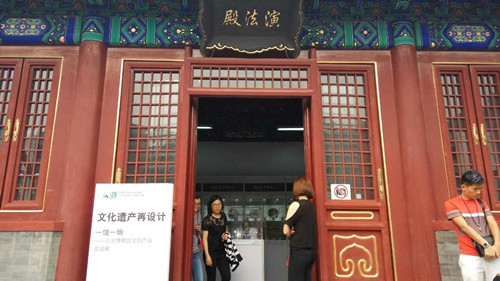

A touring exhibition of redesigned cultural heritages opened on September 23 in Beijing, and will last until the end of the month.
The exhibition intends to bring cultural heritages into people’s daily lives and to renew the relations between traditions and contemporary society through redesigning. The Beijing Museum is working with local intangible heritage programs to create cultural and creative products that show an Eastern aesthetic spirit and are in demand by consumers.
The one-week event consists of two sections, tangible cultural heritage products exchange exhibitions and display of intangible cultural heritage achievements.
 |
| The cultural heritage redesign exhibition opened on September 23 and will last for one week in Beijing. [Photo provided to China Daily] |
Li Yan, general manager of the Beijing Shengkaide Culture Development Center, said redesigning is an efficient way to inherit both tangible and intangible Chinese traditional culture.
Designers have been concentrating on redesigning cultural symbols for years and now inheritors are also realizing its importance, as it promotes integration of modern designs and traditional handicrafts.
The charm of Chinese traditions emanates from the hundred creative products telling 100 ancient stories on display. More than 60 ancient artistries, integrating with contemporary aesthetics and daily modern demands, are exhibited. Over 70 inheritors from various places in China are exploring the joining of traditional handicrafts with modern society.
As one of the Chinese Four Treasures of the Study, the production of Huizhou ink sticks is an outstanding representative of the traditional artistries.
 |
| Xishangmeishao ("happiness") coin purses on display. [Photo provided to China Daily] |
Xiang Weichen, an inheritor of ink stick production born in the 1990s, said the ink stick market was once in depression in China, but with the rise of the cultural market over the last two years the advantages that ink sticks hold compared to ink has become apparent, and ink stick usage has regained people's love.
"The creative design of ink sticks focuses on their pattern designs and their shape. For example, the traditional sticks are rectangular bars but the modern ones may have oval shapes," Xiang Weichen added.
Meanwhile, attendees can both appreciate and purchase the cultural and creative products and are able to watch the presentations by live streaming through Taobao, a popular online retailing platform in China, on their smart phones. They can even buy the products online during live shows.
 |
| Gilding skills combined with Qinghai silver and bronze handicrafts [Photo provided to China Daily] |
Li Yan mentioned that to hasten the market entry of the redesigned cultural products and to enhance their popularity with the public, new media advertising is necessary. She hopes that more and more designers will join in the redesigning after the event and use App and e-commerce platforms to draw young people’s attention to the traditional cultures.
In addition, intangible inheritors are cooperating with each other to join different traditional handicrafts together, aiming to highlight the best aspect of each art and to reveal the relations among Chinese traditional crafts.
“Cultural heritage redesigning aims to combine traditional styles and practices, modern aesthetics and practical functions to increase people’s interest in preserving cultural heritages’ value in modern society,” Li Yan added.
The event was sponsored by the State-owned Cultural Assets Supervision and Administration Office of the People’s Government of Beijing Municipality, the Beijing Design Week Organization Committee Office, the Academy of Arts and Design, Tsinghua University and the Alibaba China Vision Media Group, and has gained support from the Ministry of Culture and the Beijing Museum.